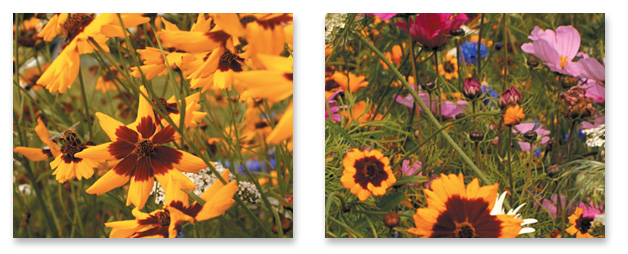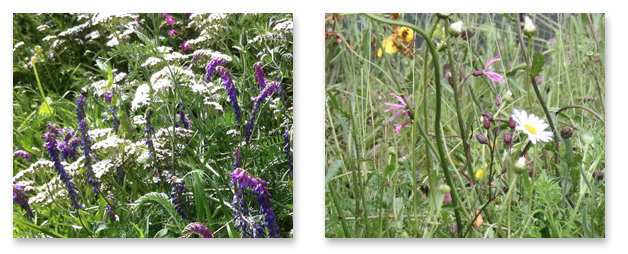Do we need to worry how we use the term wildflower meadow?
This was the question posed by Miles King, well-respected Conservation Director of the Grasslands Trust. As with the majority of things in life it depends upon your point of view. It is all in the eye of the beholder so to speak, and is a highly debatable subject.
If you are aware of the latest gardening trends you’ve probably realised that meadows are very fashionable at the moment. A meadow even if it is rather small has become a bit of a ‘must have’ at flower shows. We provided Chelsea and many other shows this year with our Wildflower Turf, where the brief was ‘as colourful as possible’.
What is clear is that two types of meadows are emerging here: the traditional ‘hay’ meadow and the pictorial, (urban) meadow. Their popularity is definitely quickly gaining momentum through more public awareness. This gain in awareness is largely credited to the Olympics planting Fields of Gold, 2012’s RHS Britain in Bloom going ‘wild about wildflowers,’ and the people who manage Hyde Park letting the grass grow long.
It is worth pointing out that the former two to a purist are not really what would be classed as a traditional wildflower meadow because they are annual mixes. The argument seems to be that by calling themselves meadows at all, these ‘pictorial meadows’ are distracting people’s attention from ancient traditional meadows – confused?

Another very important point to make with this style of meadow planting is that they are very high maintenance. Due to a lot of the species in the mix being annual they will need to be re-sown every year. The cutting of the meadow will be quite intense unlike a more traditional, native perennial wildflower meadow.
So why does all that matter? On one hand, one could argue that by planting attractive flowers, which are good for wildlife, is a good thing, surely? For example a couple converted some of their derelict land in South Petherton into a meadow which they named the field of dreams. It looks fantastic and on the face of it, yes of course it is a good thing, to green up derelict land is an admirable thing to do. However, the point that Miles King would make, would be that this has led most people to now begin to think that this constitutes as a traditional wildflower meadow.
The important point here to make is that traditional meadows feature a mixture of grasses such as crested dog’s tail, and sheep’s fescue, plus native perennial wildflowers. With an urban meadow you are likely to find non-native California poppies, lupins even sunflowers. These are designed to create a bold, colourful vivid pallete of colour within the landscape; this makes them very ‘picturesque’ rather than perhaps providing a habitat of ecological value. For wildlife, urban meadows tend to lack grasses, and if they do contain grasses they are used in a minimal manner.
Why are grasses so important? These wild tall clumps of grasses, associated with traditional wildflower meadows are vital to wildlife. They provide the food plants for many species of butterfly. They not only support the adult butterfly but the mixture of native grasses also support the larvae at different stages of their development too. One example is the Marbled White. So it is not all about providing pollen, it is also about providing a habitat that will provide shelter and breeding grounds to certain species.

To most of us who are keen gardeners or work in horticulture, it probably wouldn’t matter a great deal what we classed as a wildflower meadow, providing it looked colourful – so aesthetics would be paramount in those situations. This means that these urban annual style meadows, as with the field of dreams example, would appeal a great deal. However if you talk to a purist, then the definition of a wildflower meadow suddenly becomes rather imperative. An ecologist or conservationist, would more than likely say that it does matter – they argue that a wildflower meadow refers to the ancient traditional meadows or hay meadows and the one major thing to consider is that they are almost lost to us forever.
So perhaps there is an argument for clarifying what a ‘traditional wildflower meadow’ actually is, as well as reiterating how rare a habitat they are. This makes conserving what we have left even more imperative. The fact that the species of wildflowers are native makes a huge difference to the local wildlife. Some species of native wildflower can support several hundred different insect species along with those animals that feed on the insects: normally more than any non native species can support. They will also be suitable for our native bee species and will provide a vital nectar source for them.
However there is an argument with urban meadows: the aesthetic advantages that a meadow will bring to an urban area speaks for itself. At least these ‘Pictorial meadows’ are transforming urban spaces relatively cheaply and effectively. Not only that but by establishing meadows within urban areas introduces the concept to many people who have never had the opportunity to become interested in nature, or the countryside before. Hopefully this awareness will progress into wanting to protect the traditional wildflower meadows by realising that nature can be very fragile.